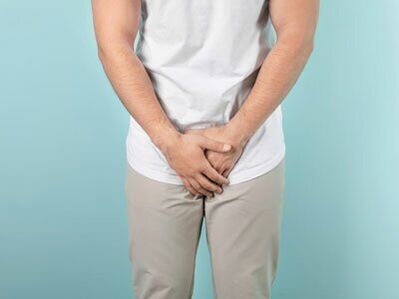
Normally, the male genital organs produce a certain secretion, which primarily has a protective function. However, changes in the nature and frequency of secretions can be an early sign of the development of a urological disease, such as a sexually transmitted infection, inflammatory or tumor process. Every man should know how to distinguish physiological secretion from pathological. If there is a deviation from the norm, you should immediately consult a doctor. Below we will consider the most common types of urethral discharge in men and their possible causes.
Male genital discharge: normal and abnormal
The secretion of the male urogenital organs exits through the urethra or urethra. The following variations of male physiological secretions are possible:
- Urine.A liquid with a yellowish tint and a weak characteristic odor. It is usually released in portions during a controlled mix. One of the urinary disorders is urinary incontinence. In this case, there is either a periodic uncontrollable discharge of urine in portions of different volumes or constant, but drop by drop. This symptom indicates a pathology of the urinary system.
- Pre-cum.Colorless and odorless mucus that is released during sexual and erotic stimulation (during masturbation, moderate erotic stimulation, during intercourse and before ejaculation). Produced by Cooper's glands located paraurethral. Preejaculate is a natural lubricant and antacid agent in the male urethra and female genitalia to increase sperm viability. A deviation from the norm is the discharge of a large amount of pre-ejaculate.
- The secret of the prostate.A gray-white opal liquid. Produced by the prostate, it is part of the ejaculate and ensures normal sperm fertilization. The discharge of prostate juice outside of ejaculation is called prostatorrhea. Normally, the secretion can be released by mechanical action on the gland (massage) and straining (during defecation). Other forms of prostatorrhea indicate disorders of the gland.
- Ejaculation.A gray-white mucous liquid with a characteristic odor. It has a complex composition. It is usually released during ejaculation during male orgasm. The release of ejaculate during intercourse and during wet dreams (for teenagers and adult men during abstinence), as well as during strong sexual and erotic stimulation, is considered physiological. Single cases of ejaculation during sleep due to fright or physical stress are not considered pathology. All other possibilities of sperm release are a reason to consult a doctor.
Often men's attention is attracted by whitish discharge on the head. This is smegma or sebaceous gland secretion. As a rule, the secretion is evenly distributed on the head, washed off during hygiene procedures and does not cause discomfort. 
If the glands are overactive or the rules of personal hygiene are violated, the secretion accumulates in the foreskin (foreskin) and becomes clearly visible. Microorganisms can use smegma for their reproduction. Therefore, the prevention of secretion stagnation is an important means of maintaining the health of the genital organs. If the secretion is too much, you should consult a doctor.
Normal discharge for men should be as described above. Any changes in the characteristics, frequency and timing of urine, ejaculate or prostate secretion should alert you and be a reason to consult a urologist.
Pathological discharge from the urethra in men
Abnormal secretion from the urethra indicates the development of a pathological process in the genitourinary tract. Men's urological diseases can be manifested not only by strong secretions. Even a slight secretion that alternates with "clean" periods should draw attention. The most common types of pathological discharge in men are:
- Glebs.Inflammatory changes in the urethra are accompanied by copious secretion of mucus. The discharge can be clear, cloudy or whitish.
- Mucous secretions.The discharge of pus from the urethra indicates an infectious process. A large amount of pathological discharge causes a feeling of stickiness and discomfort. Small - found only in the form of traces on linen.
- White discharge. White mucous discharge in men accompanies non-specific infectious and inflammatory processes. Thick, salty discharge usually accompanies candidiasis.
- Gray mystery.Gray fluid or mucous secretions may be spermatozoa or prostate secretions that flow under physiological conditions. But it is better to consult a specialist to avoid pathology.
- Bloody problems.Brown or pink urine, red or transparent mucus, stained with blood, as well as the appearance of blood in semen are signs of structural changes in the urogenital organs, which can be caused by injury, intense inflammation or the development of a neoplasm.
- Dirty discharge.Discharge with an unpleasant smell is characteristic of genital infections. A specific putrid or rotten smell emanating from the genitals should be a reason to immediately consult a doctor.
Over time, even without treatment, a man may notice changes in the nature and volume of pathological secretions. In some cases, the secretion stops, which gives the impression of recovery. However, this is often associated with the development of a chronic pathological process and its transition to a sluggish form. After some time, the man's pathological discharge from the urethra may return. The chronic course of diseases of the urogenital tract is full of serious complications (impotence, infertility, etc. )
What other symptoms can there be?
Diseases of the male genitourinary system rarely manifest themselves only as abnormal secretions. Other symptoms also require attention, because based on them, assumptions can be made about the localization of the pathological process. A man may be concerned about the following deviations:
- dysuria disorders (frequent desire, difficulty urinating, feeling of incomplete emptying, burning and stinging during urination);
- changes in urine parameters (unusual color, smell, frothiness, flakes, etc. );
- pain in the lower abdomen;
- intoxication syndrome (weakness, drowsiness, apathy, etc. );
- decreased libido;
- erectile dysfunction;
- ejaculation problems (premature ejaculation, difficulty reaching orgasm, changes in sperm properties, etc. );
- aching pain in the lower abdomen, perineum or scrotum, etc.

Pathological discharge can occur with infectious and non-infectious diseases. The following symptoms will indicate the infectious nature of the deviations:
- pain, burning when urinating;
- itching in the groin;
- rash, sores on the genitals;
- unpleasant odor coming from the genitals;
- decreased libido;
- pelvic pain;
- increased body temperature, drowsiness, weakness, etc.
You should seek help immediately after symptoms appear. The sooner the diagnosis is made and the appropriate treatment is prescribed, the greater the chance of a full recovery.
What should a man do if there is discharge from the urethra?
The doctor will help to accurately determine the nature of the pathological discharge. If there are signs of diseases of the urogenital tract, you should consult a urologist. The initial admission is as follows:
- Conversation with the patient.The doctor conducts a survey, finds out complaints and collects anamnesis. Honesty when communicating with a specialist is extremely important in determining the further tactics of the examination.
- Medical examination.The urologist visually assesses the condition of the genitals and mucous membranes. A digital rectal examination allows you to initially determine the size, structure and sensitivity of the prostate.
- Diagnostics.The urologist takes a swab from the urethra, which is then sent for microscopic analysis. According to the indications, the patient is prescribed additional laboratory methods (blood tests, urine tests and PCR tests for sexually transmitted infections) and instrumental (ultrasound of pelvic organs, prostate, etc. ) diagnostics.
Based on the results of the examination, the doctor makes a final diagnosis and prescribes the appropriate treatment.
Treatment of male discharge
In order to eliminate pathological secretions, etiotropic therapy is carried out, taking into account the cause of the existing deviations. Treatment may include the following:
- Drug therapy using antibacterial, antiviral, antiprotozoal drugs, as well as immunomodulators and anti-inflammatory drugs.
- Kinesitherapy is applied to the complex treatment of chronic infectious and inflammatory diseases.
- Surgical methods - structural changes, hyperplastic processes and neoplasms are removed mainly using minimally invasive operations.
The most common cause of discharge in men is sexually transmitted infections. In this case, conservative treatment is performed. Therapy is performed on an outpatient basis. The duration of treatment varies from several days to several months (depending on the type and form of the disease). At the end of the treatment, a control laboratory test is performed.
Prevention of male discharge
Physiological secretion reflects the normal state of health of the male reproductive system. It is not secretions that need to be prevented, but diseases of the urinary tract. To achieve this goal, urologists recommend the following activities:
- compliance with personal hygiene rules;
- wear underwear made of natural fabrics;
- selectivity in choosing sexual partners;
- use of barrier contraception during casual intercourse;
- avoid hypothermia;
- regular physical activity;
- a balanced diet;
- giving up bad habits;
- annual preventive examinations at the urologist.
In conditions of immunodeficiency, the body's sensitivity to representatives of opportunistic microflora increases. Microorganisms that usually do not cause diseases can cause the development of a non-specific infectious-inflammatory process. Therefore, in case of increased physical or psychoemotional stress, during acclimatization and treatment with immunosuppressive drugs, it is necessary to follow preventive measures especially carefully.
















































































